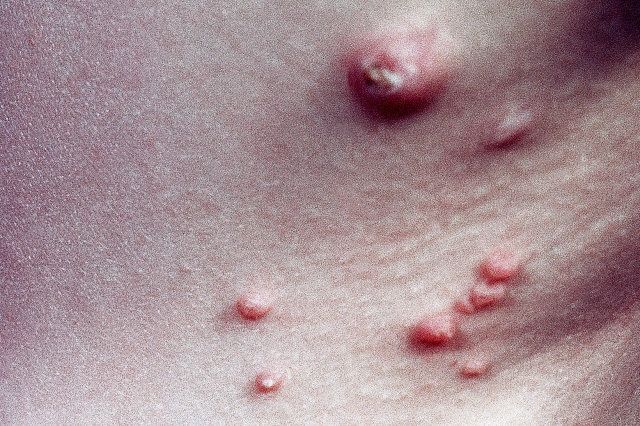
Molluscum contagiosum is a viral skin infection characterised by clusters of distinctive small, firm, raised spots with a pus-like, pearly white substance in the centre.
These spots can crop up anywhere on the body, but most commonly affect the limbs, face, chest and tummy.
The good news is that although it isn't very nice to look at and can be irritating, it doesn't usually cause pain and is not considered a serious health problem. The bad news is it's highly contagious, as the name suggests, and once a school friend or member of the family has it, chances are all the children will get it. Why has my child got it?
Molluscum is infectious and is passed on through skin-to-skin contact or via an infected object like a towel or clothing. Young children are vulnerable as they tend to play so closely together, and it's especially common in those who suffer from atopic eczema. Most adults have natural immunity to MC, so chances are, your child won't pass it on to you. All the same, it's wise to be careful about towel, flannel, and bath sharing, and about touching the affected area, just in case.
Can it be treated?
Although there are a variety of treatments available, including topical creams and cryotherapy, (which involves freezing spots off with liquid nitrogen) medical practitioners generally advise against them for young children because they can be painful and can cause scarring, and because molluscum is basically harmless, and will clear up on its own anyway.
Your GP may offer to treat the spots by squeezing or piercing the infectious centres out, or perhaps even show you how to do this yourself at home, safely and hygienically. Don't be tempted to try it without medical advice, though, because you could easily spread the virus, or introduce bacteria to the spots and cause infection. If itchiness is a problem, ask your GP or pharmacist to recommend a soothing emollient cream.
I've heard there are alternative remedies available. Should I give one a go?
There are a host of alternative remedies recommended for molluscum contagiosum, as you'll soon discover if you do some online research. Among them are the homeopathic treatment Thuja, a herbal preparation called Comfrey Ointment, applications of cider vinegar or tea tree oil, and even a posh (and rather expensive) beauty product, Elizabeth Arden's eight-hour cream. As is always the case with alternative remedies, there's no medical evidence that any of the above actually work, but plenty of people who swear by them. Always do your research carefully and only ever purchase from a reputable supplier when trying any alternative treatment.
So when will the virus clear up?
Molluscum spots usually crust over and heal within a period of six to 12 weeks, but because of its infectious nature, sometimes one patch of spots will clear up only for another to quickly develop elsewhere. However, it should clear up entirely within 18 months - and sometimes much sooner. In the meantime, encourage your child not to touch or scratch the spots, to avoid spreading the virus elsewhere on the skin. There's no need for him or her to miss school or activities like swimming. It's usual for the spots to become red and inflamed just before they disappear.
Could there be complications, or scarring?
Sometimes eczema can develop round the spots, particularly if your child suffers from atopic eczema anyway. Occasionally the spots become infected, making them sore and inflamed, in which case antibiotics can be prescribed. And rarely, they can develop around the eyes, which may mean a referral to a specialist is needed. There shouldn't be any scarring after an outbreak of MC clears up, although you may notice lighter areas or faint marks where the spots were.
"My son had molluscum"
Sam Proctor, 43, is a full-time mum to Bailey, six, and Liberty, five.
She says:
"Clusters of spots first appeared on the front and back of Bailey's legs earlier this year. He was scratching them a lot and at first I thought they must have been caused by sand mites, as we'd just come back from holiday, or perhaps fleas, as we have a cat and a dog. After a while, all the scratching was causing the spots to bleed badly, which worried me, so I took him to the GP.
"She diagnosed molluscum contagiosum, which I'd never heard of until then, and explained that it would eventually go away, although it could hang around for up to 18 months. She prescribed an emollient cream to apply daily, in the meantime, and advised us to keep his nails short so that if he was tempted to scratch, he wouldn't break the heads off the spots and spread the infection round. I tried to discourage him from scratching, but then I realised that just made him more inclined to do so, so now I keep quiet!
"The problem seemed to gradually go away then, although there has been one flare-up since, and I'm keeping my eye on it, in case it comes back with a vengeance. We're careful not to let him share towels or flannels with his sister, so he doesn't pass it on to her, and the doctor reassured us it was fine for him to keep going to school.
"It's fortunate the autumn's here and he's back in long trousers, so there shouldn't be any direct skin-to-skin contact with other children, anyway. Where he picked up the virus in the first place I don't know, but he mixes with lots of kids in several different settings, so it could have been anywhere. He had mild eczema when he was younger, and apparently that can make you more vulnerable to it. Hopefully we've seen the worst of it now."